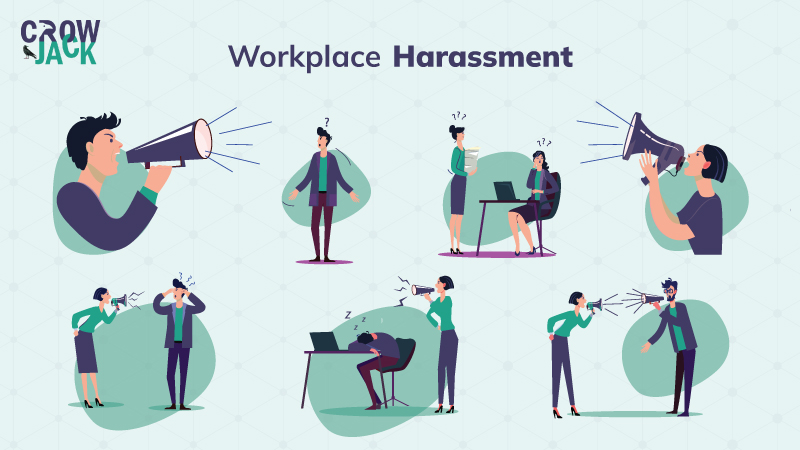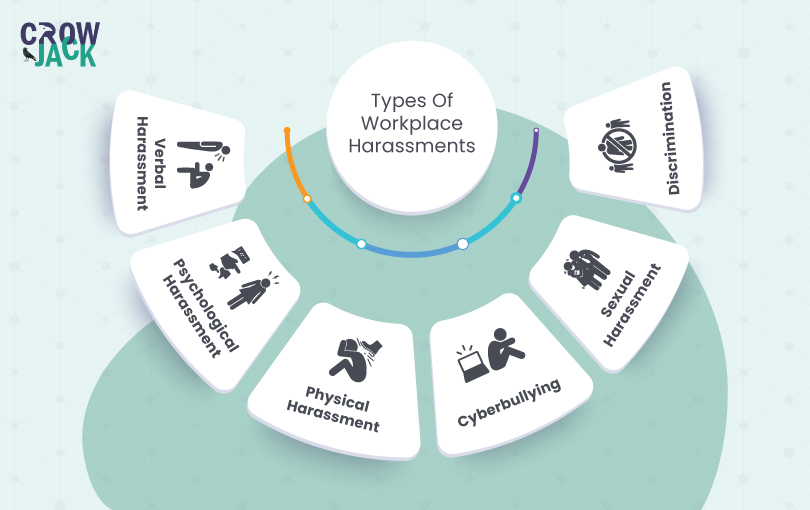Overview
Despite people's changing perceptions about many sensitive matters, harassment in the workplace continues to remain a peculiar issue. In the usual sense, the term harassment is considered synonymous with sexual harassment which is not true. Harassment in the workplace can exist in various forms and is not limited to sexual molestation. But before heading to the types, it is crucial to define workplace harassment and understand what it actually means.

What is Workplace Harassment?
Workplace harassment occurs when employees in an organization or a specific community of employees feel threatened, intimidated, molested, or exploited by their colleagues or people holding higher designations in the organization. The purpose of the harasser in such instances is to instill fear or alienation in colleagues to make them feel unsafe and uncomfortable. Further, the mediums of harassment or mannerisms can largely vary from one instance to another.
As mentioned above, harassment in the workplace can occur in different forms. The subsequent section sheds light on the different types of harassment that employees may face in the workplace.
Table of Contents
Types of Workplace Harassment

1. Verbal Harassment
Acts of verbal abuse in the workplace include the use of abusive slurs, inappropriate jokes, verbal bullying, or any other verbal gesture that can be offensive to others. It may also include unwarranted criticism or lewd comments that instill feelings of fear or disrespect in people.
2. Psychological Harassment
Incidents of psychological harassment in the workplace include stealing the credits of colleagues, setting unrealistic deadlines for subordinates, withholding important information, or expecting employees to work beyond their expertise. Such incidents subject employees to high stress and can lead to mental breakdowns and health and safety issues in a workplace.
3. Physical Harassment
Physical harassment in the workplace is often violent in nature and includes physical assault against a co-worker. Inappropriate physical gestures or touch count as acts of physical harassment irrespective of whether they cause harm or not.
4. Cyberbullying
Any kind of harassment that occurs through digital mediums is referred to as cyberbullying. It can occur in the form of texting, emailing, leaking personal details in cyberspace, or passing ill-suited comments through social media. These kinds of unethical business practices is executed with the intention of hurting, shaming, or belittling the targeted person. To validate, a recent study showed that 8 out of 10 people have been victims of cyberbullying in the workplace in the last 6 months.
5. Sexual Harassment
Sexual harassment can be both physical and verbal and can victimize any gender. Obscene comments, unwarranted touch, and sending obscene messages or videos are all acts of sexual harassment. In fact, as per the report, around 60% of the women claim to experience sexist comments in the workplace that included‘unbidden sexual advances, unwanted sexual attention in the workplace.
The Equal Employment Opportunity Commision (EEOC) states that there are two types of sexual harassment "quid pro quo" and "hostile work environment." Quid pro quo, which translates to "this for that," refers to circumstances in which people are in positions of power or authority make explicit or implied demands for sexual favours from employees in exchange for employment benefits (like promotions or pay raises) or to avoid negative outcomes (like termination or demotion). Quid pro quo harassment is when a manager insists a worker into having a sexual relationship by threatening to terminate them if they refuse.
On the other hand, when there is a persistent pattern of speech or behavior in the workplace that is severe and pervasive enough to produce an intimidating, degrading, or offensive environment, which has a detrimental effect on a person's capacity to perform their job, it is considered hostile workplace harassment. Hostile work environment harassment, in contrast to quid pro quo harassment, which entails requests for sexual favours in exchange for benefits or to avoid harm and is typically committed by someone in a position of authority, can be committed by anyone present in the workplace, including a coworker, supervisor, subordinate, vendor, customer, or contractor.
6. Discrimination
Discrimination in the workplace can occur on the basis of age, gender, disability, sexual orientation, race, nationality, or any other differentiation. This can be done with the intention of making someone feel inferior or with the intent of hurting the victim. This unknown favoritism in the workplace can occur between employees or between employer and employee. Moreover, this harassment can occur consciously or subconsciously because sometimes people unknowingly are inclined towards a person with the same practices, age, or nationality.
Probing further, to address the growing issue of workplace harassment, leaders or employers need to take actionable measures to mitigate harassment issues in their organizational structures. Some effective measures are proposed below that businesses can use as a template for alleviating workplace harassment.
What are the solutions to harassment in the workplace?
- Promoting an open-door policy: Organizational leaders should promote an open-door policy wherein employees feel confident and comfortable enough to walk up to their leaders and report issues of harassment. Leaders should make employees believe that they are available for open communication whenever needed.
- Bringing stricter and actionable policies. Subject to the issues within an organization, the top management should be determined to bring strict and actionable policies to take decisive and immediate actions against complaints of harassment. The policy framework should account for every form of harassment and quick investigations should be launched to probe claims.
- Cultivating a culture of diversity and inclusion: To counter the occurrences of racial or other forms of discrimination in the workplace, leaders should look to promote diversity and inclusion through D&I activities and effective management of diverse workforces.
- Leading by example: Leaders within organizations should lead from the front to portray the right attitude and conduct in the workplace. Leaders are often viewed as role models and leaders need to manifest zero tolerance for discriminatory practices or inappropriate behaviors. They should set high standards of equality, integrity, and respectfulness in the workplace.
- Offering EQ training to employees: Emotional intelligence is becoming increasingly important in the workplace. In fact, statistics on EQ in the workplace cite that 95 percent of HR managers feel it is important for employees to have a high EQ. Having said that, to promote greater empathy, compassion, and respectfulness among employees, businesses should offer EQ training as an effective measure against workplace harassment. When employees have high empathy and respect for other's feelings, they are less likely to engage in discriminatory practices.
- Creating multiple channels of reporting harassment: The top management should initiate multiple channels of reporting instances of harassment. Employees should have different ways in which they can report their harassment experiences. Besides, they should also have the privilege to report their harassment experiences anonymously. Additionally, companies can also appoint an ethics officer to which victims can directly report the issue and the officer can initiate an immediate probe.
For a better comprehension of the issue, it is essential to go through some workplace harassment examples. That being the case, below given is the real case study of Reema Yelda that has been the victim of workplace harassment. So, let's dive into the case without any further ado.
Real-life case study
Reem Yelda Vs Sydney Water
After working for 14 years in Sydney Water as a liaison officer, in 2015, Yelda agreed to get photographed to promote a campaign named SafeSpine by Vitality Works to promote workplace health and safety. However, in April 2016, she found her photograph outside the men's toilet at Sydney Water’s facilities along with a caption written in bold letters “Feel great - lubricate!”. Yelda found this utterly humiliating and complained to her supervisor in the company. The supervisor accepted that the poster was inappropriate and even presented a written apology and immediately ordered the removal and shredding of all the Reem Yelda posters. However, the company failed to properly investigate the case and catch the culprit responsible for the act. Following this, Yelda filed a complaint against both stakeholders involved in the case, i.e. Sydney Water and Vitality Works.
After the investigation of the case, and the failure of the company in providing evidence of conducting the appropriate investigation, the NSW Civil and Administrative Tribunal found that the company was at fault under section 22B of the Anti-Discrimination Act 1977. As compensation for this unethical act, both the corporations were liable to pay $100,000 to Reem Yelda.
In this case study, we observed, that the company’s unethical behavior and carelessness towards proper investigation cost them a huge amount of money. Even after the issue was taken to the company, they failed to conduct a proper investigation and hence, the case was taken to the NSW Civil and Administrative Tribunal.
Key takeaway - With the assistance of this case study, we got to know that It is an obligation of the company to take strict actions against any report of harassment within a short time otherwise, they can land up in some serious legal trouble.
FAQs
What is the difference between harassment and discrimination?
Discrimination and harassment are two different yet connected ideas. Discrimination refers to the unfair or unfavourable treatment of someone based on protected traits, whereas harassment refers to objectionable actions or behaviour directed at an individual or group. Discrimination can take the form of harassment.
Can I report workplace harassment anonymously?
To safeguard the privacy of those who report harassment, many organisations have set up anonymous reporting mechanisms. To learn more about anonymous reporting, speak with your company's HR staff or study your workplace policies.
What should I do if I experience workplace harassment?
It's critical to act if you face workplace harassment. The first step is to thoroughly record the episodes, including dates, times, places, and any witnesses. In accordance with the policies of your employer, report the harassment to your supervisor or the human resources division. Think about getting legal counsel if the harassment continues or is not satisfactorily addressed.
Are all forms of workplace harassment illegal?
Workplace discrimination based on protected traits like race, sex, religion, etc. is prohibited in many nations. However, rules and policies governing the workplace might differ from one jurisdiction to the next, so it's important to know the exact laws that apply in your area.
Next Issue
Health and Safety Issues
 Proof Reading
Proof Reading  Copy Writing
Copy Writing  Resume Writing
Resume Writing  Blogs
Blogs Guides
Guides SOP's
SOP's Student Resources
Student Resources Research Topics
Research Topics Login
Login Register
Register